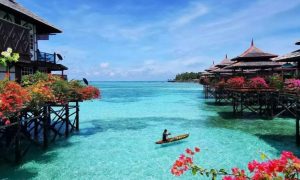This post was written by Petra O’neil
Travel writer Petra O’Neil explores the stunning architecture of the temple towns in Southern India.
Leaving Chennai, the capital of Tamil Nadu, behind, Guna (my driver) and I made an early start heading south along the coastline with the refreshing smell of salt air from the Bay of Bengal on one side and green rice paddy fields on the other. Veering past cows, auto rickshaws, and overloaded trucks and buses, I was in no hurry to arrive at our destination of Pondicherry but, as is the case for the most pleasurable journeys, time slipped by too fast.
Few things in India express the continuous presence of Hindu gods better than the ancient, massive temple complexes found in Tamil Nadu. The so-called “temple circuit” is the main draw for today’s travellers, as it has been for centuries. We arrived in Mamallapuram, which has some of the oldest stone temples in India, to find it already crowded with Indian tourists and juice vendors standing next to carts piled high with fresh green coconuts.
Temples Of Mamallapuram
The Five Rathas are an example of Indian rock-cut architecture dating from the 7th century. Created during the reign of King Narasimha Varman I (630-670CE), each temple was carved from one single massive slab of pink granite in the Dravidian style. Named after the Pandavas (Arjuna, Bhima, Yudhishtra), Nakula (Sahadeva), and Draupadi, they are associated with the great epic Mahabharata.
Perched on a promontory overlooking a sandy beach and the crashing waves of the Bay of Bengal is the town’s most important architectural site, the Shore Temple. This temple was built from 700-728CE during the Pallava dynasty and is considered to be one of the oldest structural stone temples (not rock cut) in southern India and a forerunner of the Dravidian style.
Two carved layered towers, badly eroded by centuries of exposure to the elements of wind and salt spray, are of a style that had enormous influence on the development of later temples, both in India and Southeast Asia. As one of the group of monuments at Mamallapuram, it has also been classified as a World Heritage Site.
Perhaps the most beautiful of the monuments found here is one of the world’s largest bas reliefs known as Arjuna’s Penance. Dozens of figures from Hindu mythology are carved from the surface of an enormous granite boulder. The central scenes depict a well-known tale from the Mahabharata, that of the revered warrior Arjuna entering the forest to seek the aid of Shiva in a coming battle.
Pondicherry And Beyond
Heading further south, we continued on to Pondicherry, a former French colonial town that deserves a few days attention for the historic architecture and laid-back, funky boutiques and cafes. When I next saw Guna, he looked despondent; I had thought I was doing him a favour by giving him a day off while I explored on foot, but he had spent the day sitting on the beach waiting.
We drove southwest from Pondicherry to reach the first of three great Chola temples, Airavatesvara temple at Darasuram. Built of granite during the reign of Rajaraja II (1146-72CE), the temple includes friezes of dancing figures, elephants, and crocodiles, and sculptures of black basalt.
Gangaaikondacholapuram is an absolute joy to behold. Once the capital of the Chola King Rajendra (1012-44CE), the town has all but disappeared, except for the temple he built to rival that built by his father, Rajaraja the Great, in Thanjavur.
The temple is over 100m long and 40m wide, with a long colonnaded hall linking the hall to the shrine. The detailed statues and friezes are as remarkable as the temple’s lengthy name.
The drive onwards took us deep into the countryside, past roadside villages and flat, dry landscape. In Thanjavur I visited the greatest architectural achievement of the Cholas, who ruled a large part of southern India from this city: the Brihadishwara, or “Big Temple.” This is an achievement of King Rajaraja (985-1012CE), and the impressive scale is apparent as soon as you approach it, with the tower topped with a massive 80-ton dome of carved granite. There was a surge of visitors rushing to queue for entry to the inner sanctum to be blessed by priests and gaze at the large black lingam.
Trains And Travel
I left Guna to join the Golden Chariot, a luxurious train, in time for dinner. A splendid thali was served on antique silverware in a dining car that was coloured in various shades of pink. My compartment, also in shades of pink, was spacious and comfortable, with a large viewing window to observe the passing scenery.
Next morning, we arrived in Madurai, one of the most ancient cities in India. It is only fitting that, at the centre of its busy commercial area, stands what some call the most magnificent temple complex on the subcontinent. It is actually two temples joined; one dedicated to Minakshi and the other to her husband Sundareswarar. Unlike many temples in India, the female god is dominant here.
Hundreds of visitors were gathered around the entrance, hoping to get a glimpse of the statue of Sundareswarar. It was not just the most majestic Chola temples I had seen, it seemed the many Hindu pilgrims were joyful to be there too. We returned to the Golden Chariot late that night, and as we departed I saw many of the pilgrims I had seen that day preparing to take rest by the roadside.
We continued our train journey overnight to Kanyakumari, where the Bay of Bengal meets the Indian Ocean and the Arabian Sea. Being woken at an ungodly hour was worth the sight: when the night sky turned bright pink and orange, I saw that thousands of pilgrims had gathered. The profound significance that the temple circuit has for Hindus leaves the “normal” traveller moved for having been witness to it.
———————————————————————————————————
Travel Details
Getting there – Malaysia Airlines, Air Asia, Silk Air, and Jet Airways fly to Chennai.
Getting around – Indian trains link Chennai, Tiruchirappalli and Madurai, but it is far easier to hire a car and driver to see the temples. The Golden Chariot luxury trains offer two tourist itineraries; visit www.goldenchariot.org.
Accommodation – in Chennai, the Vivanta by Taj Connemara is centrally located (www.vivantabytaj.com). In Ponchiderry, the Hotel de l’Orient is a restored boutique hotel (www.neemranahotels.com), while in Madurai the Royal Court Hotel has a central location (www.royalcourtindia.com).
———————————————————————————————————
Source: The Expat July 2013
What are your thoughts on this article? Let us know by commenting below.No registration needed.
















